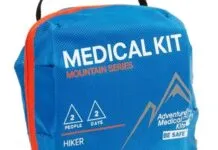The launch of the first BJ40 signified a sea change in Island Packets approach to boat building, one that was more about weight control than quality control.
Hull: The fiber-to-resin ratio was increased through a vacuum-assisted resin infusion, a process that better wets out the laminate and simultaneously squeezes out all the excess resin. The mechanical properties and blister resistance of vinylester resin are better than its polyester cousin, and this uptick in materials and laminating process dovetailed with the use of Divinycell foam to deliver a strong, stiff, one-piece hull with a an inward-turning flange. The BJ40 hull carries a 10-year warranty against osmotic blistering.
Deck: Resin infusion was used in the deck, and a foam sandwich structure delivered stiffness with a significant weight reduction. Extra units of laminate delivered a more crush-resistant base for high-load hardware such as winches, cleats, stem fittings, etc. The decks are finished with Awlgrip LPU paint and nonskid surfaces feature Awlgrips Griptex powder additive.
Hull-to-deck joint: The BJ40 has a shoe box shaped hull-to-deck joint that affords a lot of surface area contact; its secured by adhesive sealant and mechanical fasteners. The deck flange edge is hidden by a rub strake made of a tough black, nicely contoured elastomer capped with a mechanically fastened stainless steel half-round molding that runs from stem to stern.
Rudder and keel: A fairly large surface area, high aspect ratio, semi-balanced spade rudder is supported by an efficient bearing system, and is linked to a twin-wheel Edson steering system. The carbon-fiber, pre-preg composite rudder post is vacuum infused, along with structural foam, into the rudder mold; the tapered post measures 2.8 inches in diameter. The lead and antimony bulb keel incorporates cast-in-place, J-shaped keel bolts, and the stub it attaches to is a foam-free solid fiberglass structure.
Rig: The nicely tapered Sparcraft T6061L alloy spar and boom have been carefully fitted out with Harken and other top-notch hardware. The outboard chainplate, double spreader rig, and headstays are a sensible combo. Only a really close look offers anything to nitpick about. In this vein, we noted that the upper spreader tips are twin holed but only the intermediate shroud is carried, a single slot tip should have been used. And the strap-type toggles have a bit too wide a jaw span for the chainplates. Minor yes, but in such a well-designed, well-built boat, nothing should go unnoticed.




































